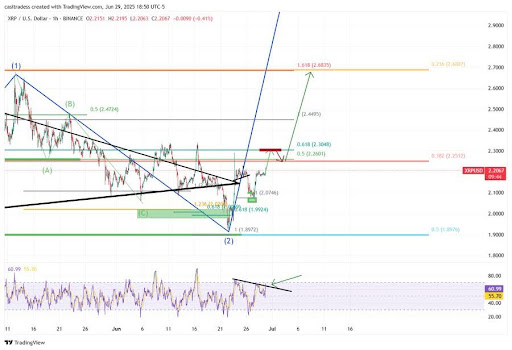
The Comprehensive Guide to the Bitcoin Rainbow Chart: Decoding Cryptocurrency Trends in 2024
Introduction to the Bitcoin Rainbow Chart
The Bitcoin Rainbow Chart has emerged as a pivotal tool in the cryptocurrency investment landscape. This unique chart, grounded in logarithmic regression, offers a colorful representation of Bitcoin’s historical price movements. It’s more than just an analytical tool; it’s a window into the market psychology of Bitcoin investors.
The Genesis of the Rainbow Chart
Tracing its roots back to a Reddit user in 2014, the Rainbow Chart has evolved from a community joke to a serious analytical tool. It reflects the vibrant and dynamic nature of the Bitcoin market, marrying historical data with colorful visualization.
Decoding the Colors: Understanding Market Sentiments
Each hue on the Rainbow Chart denotes a different market phase, ranging from deep reds indicating ‘maximum bubble territory’ to blues suggesting ‘fire sale’ conditions. These colors serve as a quick reference to gauge market sentiments.
2024: A New Era for the Bitcoin Rainbow Chart
As we navigate through 2024, the Bitcoin Rainbow Chart remains a crucial tool for understanding market dynamics.
The Bitcoin Market in 2024: An Overview
This year has seen significant developments in the cryptocurrency world. With the increasing adoption of Bitcoin and its recognition as a legitimate asset class, the Rainbow Chart has become more relevant than ever.
Interpreting the Rainbow: Bullish and Bearish Scenarios
The chart’s predictions for 2024 show a wide range of potential outcomes. The ‘Maximum Bubble Territory’ suggests a significant surge in Bitcoin’s value, while the lower spectrum indicates caution.
Integrating the Rainbow Chart into Investment Strategies
The Rainbow Chart, while useful, should not be the sole basis for investment decisions. Its speculative nature necessitates a balanced approach, combining it with other market analyses and tools.
A Word of Caution: The Chart’s Limitations
Despite its popularity, the Rainbow Chart is not a crystal ball. It’s important to understand its limitations, particularly its reliance on historical data, which may not always predict future trends accurately.
The Evolution of Bitcoin and its Impact on the Rainbow Chart
As Bitcoin continues to evolve, so does its interpretation on the Rainbow Chart. The chart’s adaptability to market changes makes it an invaluable tool for investors.
The Significance of Historical Patterns
Historical data plays a crucial role in the Rainbow Chart’s predictions. By analyzing past trends, investors can glean insights into potential future movements of Bitcoin’s price.
The Chart’s Role in Modern Investment Portfolios
Incorporating the Bitcoin Rainbow Chart into a diversified investment portfolio can offer a unique perspective on potential market movements, aiding in decision-making.
The Future of the Bitcoin Rainbow Chart
Looking ahead, the Bitcoin Rainbow Chart is poised to remain a key player in cryptocurrency analysis.
Adapting to Changing Market Dynamics
As the cryptocurrency market evolves, the Rainbow Chart will need to adapt, potentially incorporating new data and methodologies to stay relevant.
The Enduring Appeal of the Rainbow Chart
Despite its limitations, the Rainbow Chart’s visual appeal and simplicity make it an enduring tool for both novice and experienced investors.
Conclusion: Navigating the Cryptocurrency Landscape with the Rainbow Chart
The Bitcoin Rainbow Chart is more than just a colorful graph; it’s a reflection of the ever-changing landscape of cryptocurrency investment. As we move forward in 2024, it will continue to be a valuable tool for navigating the complexities of the Bitcoin market.
Frequently Asked Questions (FAQ’s)
What is the Bitcoin Rainbow Chart?
The Bitcoin Rainbow Chart is a logarithmic regression chart that uses color-coded bands to indicate different market sentiments and potential future price movements of Bitcoin.
How does the Bitcoin Rainbow Chart work?
It works by mapping Bitcoin’s price history on a logarithmic scale and overlaying it with multi-colored bands, each representing a specific market sentiment or investment strategy.
Is the Bitcoin Rainbow Chart reliable for investment decisions?
While the chart offers insights into market trends, it should not be solely relied upon for investment decisions due to its speculative nature and reliance on historical data.
What do the colors in the Bitcoin Rainbow Chart signify?
Each color band on the chart represents a different market phase, ranging from ‘maximum bubble territory’ (red) to ‘buy’ (green) zones.
Can the Bitcoin Rainbow Chart predict the exact price of Bitcoin?
No, the chart is not designed to predict exact prices but rather to give a general indication of market sentiment and potential price trends.
How often is the Bitcoin Rainbow Chart updated?
The chart is typically updated regularly to reflect the latest Bitcoin price movements and market trends.
What makes the Bitcoin Rainbow Chart popular among investors?
Its simplicity, visual appeal, and the intuitive way it presents complex market data make it popular among both novice and seasoned investors.
How did the Bitcoin Rainbow Chart originate?
The chart originated from a Bitcoin enthusiast on Reddit in 2014 and has since evolved into a more sophisticated analytical tool.
What should be considered when using the Bitcoin Rainbow Chart?
Users should consider other market analyses, current economic factors, and their own investment strategies alongside the chart.
Does the Bitcoin Rainbow Chart apply to other cryptocurrencies?
While primarily designed for Bitcoin, the concept can be adapted to analyze other cryptocurrencies, though its effectiveness may vary.





